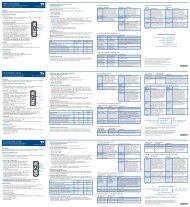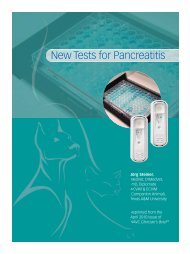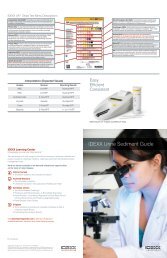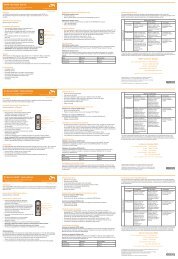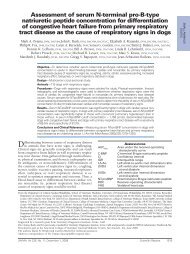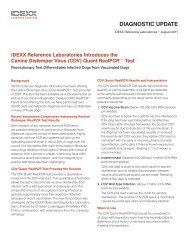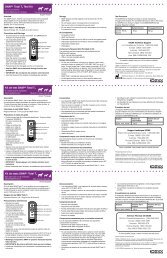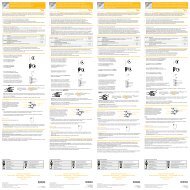Truth About Lyme Disease Diagnostic Update - IDEXX Laboratories
Truth About Lyme Disease Diagnostic Update - IDEXX Laboratories
Truth About Lyme Disease Diagnostic Update - IDEXX Laboratories
You also want an ePaper? Increase the reach of your titles
YUMPU automatically turns print PDFs into web optimized ePapers that Google loves.
DIAGNOSTIC UPDATE<strong>IDEXX</strong> Reference <strong>Laboratories</strong> • November 2012The Importance of Differentiating Exposure from Infection withBorrelia burgdorferi in the Diagnosis and Treatment of Canine <strong>Lyme</strong> <strong>Disease</strong>The C 6 technology used by <strong>IDEXX</strong> in USDA-licensed kits differentiates <strong>Lyme</strong>-infected from vaccinated dogsIntroductionThe C 6 peptide used in the <strong>IDEXX</strong> SNAP ® 3Dx ® , SNAP ® 4Dx ®®Plus and <strong>Lyme</strong> Quant C 6 tests has played a foundationalrole in veterinary infectious disease diagnostics for the last 10years and has been employed as a method of <strong>Lyme</strong> diseasesurveillance in dogs across North America. Recently, the Centersfor <strong>Disease</strong> Control and Prevention (CDC) has recognized that<strong>Lyme</strong> surveillance data from dogs can be a valuable tool forpredicting the emergence of <strong>Lyme</strong> disease in humans within newgeographic regions. 1 This diagnostic update on <strong>Lyme</strong> C 6 testingwill provide information on:• Why VlsE (C 6 ) is expressed by the spirochete.• How the C 6 peptide is used in <strong>Lyme</strong> diagnostics.• When quantitative measures of C 6 may help in themanagement of subclinical cases of Borrelia burgdorferiinfections.BackgroundThe C 6 peptide represents one of the constant or invariableregions (IR 6 ) of the VlsE protein. VlsE is a surface protein ofB. burgdorferi. It is encoded by the VlsE gene, which containsnumerous variable sequences along with the six constant regionsequences. The organism selects and expresses differentvariable sequences over time in order to successfully evadethe host immune response and survive within the mammalianhost. The VlsE gene is only expressed in the mammalian host.The gene is not expressed when the organism is within the tickor when it is grown in culture to produce the <strong>Lyme</strong> vaccine.Therefore, antibodies generated as a result of <strong>Lyme</strong> vaccinationdo not react with the C 6 peptide. 2 Antibodies to the C 6 peptideare an indication of natural infection with B. burgdorferi.Surface proteins change with different stages of infectionOsp proteins, like VlsE, are also surface proteins ofB. burgdorferi. OspA is important for localization of the spirochetewithin the midgut of the tick and is typically not expressed bythe spirochete when it is in the mammalian host. OspC beginsto be expressed by the spirochete as the tick takes its bloodmeal. Expression of OspC facilitates movement of the spirochetefrom the midgut of the tick to tissues of the host. Both OspA andOspC are targets of <strong>Lyme</strong> vaccines. OspF is generally expressed4–6 weeks after the spirochete enters the mammalian host with aresulting antibody response that occurs 6–9 weeks postinfection 3(see figure 1).Protein-Specific Antibody Concentrations0OspCOspAC 6 detectionOspF1 2 3 4 5 6 7 8 9 10 11 12Weeks After InfectionHost immune response to OspCThe early host immune response is primarily directed againstOspC. As host antibody titers to this protein increase, thespirochete must turn off expression of OspC or risk eliminationfrom the host. OspC expression is greatly reduced by 10 dayspostinfection, 4–6 and the OspC antibody response may be variableor begin to wane as early as 49 days postinfection. 3,7C 6 antibodies are indicative of infection not exposureAs OspC expression begins to decrease by 10 days postinfection,the VlsE gene is being turned on to allow the organism to employ anovel mechanism of host evasion; it disguises itself with a variablearray of different coat proteins. The VlsE protein is only producedafter the bacteria has been in the mammalian host for 7–21 days. 5Antibodies to C 6 indicate infection because the spirochete mustinfect the dog and be biologically active for at least a week beforesufficient amounts of VlsE protein are produced to stimulate theantibody response. Antibodies to C 6 may be detected as early as3–4 weeks postinfection. 2 Dogs that are protected from infectionby vaccination may make more antibodies to OspA and OspCin response to tick–transmitted organisms. However, they do notmake antibodies to the C 6 peptide. The organisms appear to becontrolled by the immune system prior to the expression of VlsE;this observation provides additional evidence that antibodies toC 6 distinguish infection from exposure. 8C 6clinical signsFigure 1. Schematic representation of antibody concentrations to differentouter surface proteins of B. burgdorferi. Antibodies to C 6 precede the onsetof clinical signs and indicate infection.
Relative Antibody ResponseIncreased levels of C 6 antibodies reflect active infectionBiological activity on the part of the organism is reflected bycontinuous antigenic variation in response to immune pressurefrom the host. In other words, an active spirochete must continueto disguise itself with new coat proteins to evade the antibodyresponse of the host. Each new coat (VlsE) protein that isexpressed also contains C 6 . So, as the dog makes antibodiesto the new coat proteins, it also makes more antibodies thatreact with the C 6 peptide. Experimental infection studies havedemonstrated that the higher the C 6 antibody levels, the greaterthe number of organisms that could be recovered from the skin ortissues of infected dogs. Furthermore, these studies have shownthat these organisms are more likely to survive in culture whenremoved from the dog. 2,8,9 Concentrations of C 6 antibody declinerapidly in response to antibiotic therapy and so do the numbersof organisms that can be recovered from the dog. 2,9,10 As theorganisms are eliminated or driven to a state of dormancy, theyare no longer changing their coat proteins in an attempt to evadethe immune response. There is no further stimulation of the C 6antibody response and as a result, C 6 antibody concentrationsdecline (see figure 2).InfectionFigure 2. Active B. burgdorferi infections stimulate the C 6 antibody response.At initial infection, a spirochete ( ) expresses OspC on its surface (red). With time,it must change the coat protein to evade the immune response (a OspC, red line).So by 10 days postinfection, the spirochete no longer expresses OspC and insteadbegins to express different VlsE coat proteins over time, each of which includes C 6 .This drives C 6 antibody concentrations higher. Following treatment, the organismbecomes dormant, no longer expresses VlsE and C 6 antibody concentrations decline.Quantitative concentrations of C 6 antibodies helpto identify and monitor dogs that may benefit fromtreatment.Because quantitative C 6 antibody concentrations correlate with®organism load and viability, the <strong>Lyme</strong> Quant C 6 Test can helpto identify B. burgdorferi-infected dogs that would benefit fromantibiotic therapy, including those that lack the more recognizableclinical signs or laboratory abnormalities of <strong>Lyme</strong> disease. Ingeneral, B. burgdorferi-infected dogs, humans and nonhumanprimates with high concentrations of C 6 antibody respondto antibiotic therapy with a marked reduction in C 6 antibodyconcentrations. 9,11,12 Thus, even in dogs that show no clinical signs,treatment response can be monitored by measuring a reductionin the concentrations of C 6 antibody. Failure of the test to show areduction in the concentration of C 6 antibody following treatmentC 6a OspC a VlsE a VlsE a VlsE a VlsETimeTreatmentmay indicate treatment failure, recrudescence, noncompliancewith administering medication or reexposure to B. burgdorferi. C 6antibody concentrations do not correlate with disease or predictwhich dogs will become sick with <strong>Lyme</strong> disease or <strong>Lyme</strong> nephritis.Dogs with lower concentrations of C 6 antibodies (




